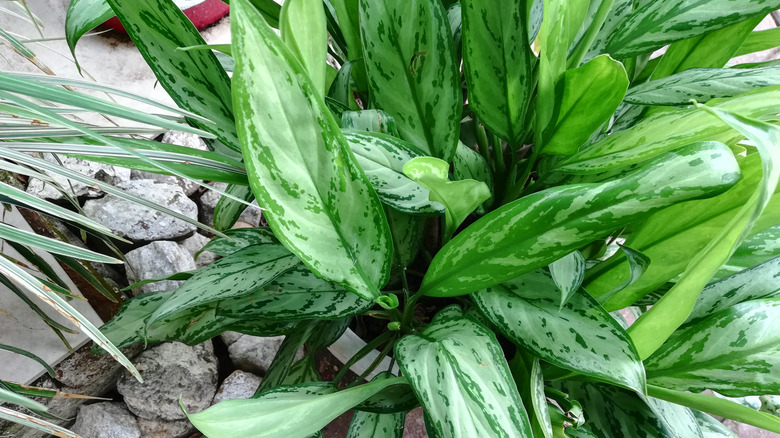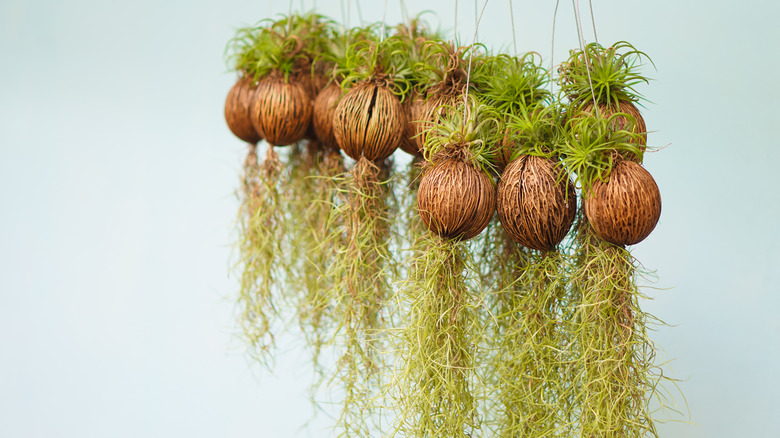20 Easy To Grow Houseplants That Don't Need Drainage
Have you ever spotted the most adorable flower pot only to flip it over and discover there are no drainage holes? while it might look great in your home with any plant inside of it, everyone says that houseplants need adequate drainage. Don't fret — there is a solution. Many gardeners suggest filling the bottom of your non-draining pots with pebbles, drilling holes yourself, or using decorative pots as sleeves for uglier, plastic ones. While these suggestions can work great, it's still possible to grow certain plants in a pot like this without all the extra work.
Several well-known plants can grow in pots such as this if you are careful with their watering schedule. Croton, African violets, and even larger plants like Bird of Paradise can grow this way for many years. Additionally, there are also a few houseplants, like venus fly traps, that prefer to grow in extremely wet soil which these containers can offer. If this sounds like something you are ready for, check out our following collection of plants that will make the perfect companion to your cute but drain-less flower pot.
1. Snake plant
Snake plants (dracaena trifasciata) can live without much water for quite some time. Although they can be harmed by overwatering, it's fairly easy to grow them in pots that retain water. Because the succulent thrives out of direct sunlight and takes in water slowly, it won't need to be watered often, and keeping its soil somewhat dry will reduce the chances of developing root rot. The best way to be certain that the plant roots stay healthy is to allow the soil to dry completely between waterings.
2. Oleander plant
Oleander (nerium oleander) is a shrub species that can grow quite tall — up to 19 feet if it is given the opportunity. It grows extremely fast, but it can be kept under control when in a container. Oleander is able to grow in poor soil and it isn't picky about water. In fact, the shrubs often grow near rivers and other water sources, and they have proven themselves tolerant of fluctuating dry spells and plentiful water. Still, for best growth, this drought-tolerant plant should be given minimal water to ward off diseases from overwatering.
3. Chinese evergreen plant
Chinese evergreen plants (aglaonema modestum) are well-known for their giant leaves that can range in color from light cream to very dark green. Like some other houseplants that don't necessarily need drainage, the leafy plant prefers low light conditions and it has relatively low water needs. Only water it when the soil is completely dry and keep in mind a little goes a long way. The soil should not be saturated each time you water.
4. Rough horsetail
Rough horsetail (equisetum hyemale), also known as scouring rush horsetail, is a non-flowering sedge that enjoys wet conditions. Typically planted in rain gardens or as a water plant, you can grow this perennial indoors to keep its aggressive growth under control. Because it grows well in wet conditions, you can place it in up to 4 inches of standing water. There is no need to be afraid of overwatering, keeping the soil very damp will provide you with the best growth.
5. The Philippine evergreen plant
The Philippine evergreen plant (aglaonema commutatum,) which enjoys high humidity and consistently moist soil is a good contender for a pot that will hold some extra moisture. This low-light houseplant could grow happily in just about any container you give it, provided that you are careful not to create a murky pool of soil and standing water. This will surely cause its roots to rot or lead to other similar problems that commonly trigger plant death.
6. Spanish moss
Spanish moss (tillandsia usneoides) is a member of the air plant genus, which means it is an epiphytic plant that does not need soil to grow. Air plants and other epiphytes are a good growing solution for these types of containers because they can simply sit on top and be misted or taken out to water more deeply. Remember that the key to growing a thriving air plant is bright indirect light and humid air conditions. Too little light or moisture will cause the moss to shrivel and lose its color.
7. Spider plant
The spider plant (chlorophytum comosum) is an African perennial that shows off green and cream-colored leaves that produce small offsets in maturity. It's among the easiest and most-popular houseplants to grow due to its tolerance to drought and neglect. Spider plants have very low water needs and they can go a long time without water. They grow nicely in hanging baskets or in pots kept on shelves that allow the leaves to cascade over the edge.
8. Schefflera plants
Schefflera plants (schefflera actinophylla), which are more often called umbrella trees, are tall growing plants that can reach up to 40 feet tall in their natural environment. These trees produce shiny dark green and palmately compound leaves. Each grouping of leaves arches downward which gives them an umbrella-like appearance, hence the common name. It's recommended to grow the trees in a container indoors or outdoors, but be sure to keep track of how much water it is receiving.
9. Dracaena
Dragon trees (dracaena marginata,) like umbrella trees, can grow tall, but they stay much smaller when grown indoors. It may be easier to grow them indoors, in fact, because their water needs can be difficult to get used to. While the plant is drought-tolerant, it still needs watering often. Allow their soil to completely dry out before watering again and regularly check for root rot. Your dragon tree should be kept in an indirectly sunny location. With good care, it will show off bright leaves in various shades of yellow, pink, green, and white.
10. Aloe vera
Succulents such as aloe plants (aloe barbadensis) are a favorite to grow in unusual pots and containers. It's recommended that you grow yours in one that allows the soil to dry quickly, such as in a terracotta or clay pot. Containers made of this material are porous and help water evaporate more easily. However, the trick is really in watching how much water you are providing the plant with. Especially if you are keeping your aloe plant in a shadier location, you will need to keep watering to a minimum.
11. Pothos
Pothos (epipremnum aureum) is notorious for being extremely low-maintenance. For many indoor gardeners, pothos plants are frequently forgotten, and they really don't mind this. These drought and neglect-tolerant plants easily handle the effects of being forgotten and will continue to grow under adverse conditions. They are well-suited to hanging baskets and other decorative containers as long as they are not continually overwatered. Pothos prefer soil that is too dry to soil that is too wet, in fact, they can grow in very dry soil for some time before they start to wither.
12. Philodendron
The heart-leaf philodendron (philodendron hederaceum), which is easy to confuse with pothos, actually has quite different growing requirements. The vine is not very drought-tolerant, so you must watch out for root rot when you are watering it. Keep its soil moist, but not soggy, and be sure to give it less water when it is dormant in the winter. It's advised to place it in an area where it receives indirect sunlight. With good care, it should thrive, even if its container doesn't drain.
13. Kupukupu fern
Kupukupu ferns (nephrolepis cordifolia), which are also called sword ferns, narrow sword ferns, and fishbone ferns, can grow in a range of conditions, especially when it comes to water. They may thrive in dry, moist, or wet conditions in soil that is made up of clay, sand, or organic materials. The adaptable plant can also grow in full sun, full shade, and every light type in between. Despite its flexibility, it is best to keep its soil moist, not wet, which will require you to water it often.
14. African violet
African violets (saintpaulia ionantha) are among the easiest flowers to grow indoors. The roots of the plant like water, but its crown does not. African violets are threatened by crown rot, so you should be mindful that the plant matter on top of the soil is never sitting in water. When growing as a houseplant, be sure that your flower is positioned to receive some indirect sunlight. If you care for it properly, it will reward you with its freely flowering blooms which can be purple, blue, pink, or white.
15. Bird of Paradise
Bird of paradise plants (strelitzia reginae) are usually grown outdoors because of their tall growth and love of sunlight. However, not every state can provide it with the high temperatures that it needs to survive year-round. In colder regions, the flower is grown indoors in containers that can be kept consistently warm and moist. The perennial houseplant is a lover of loamy soil and plentiful water, however, its drought-tolerant nature will allow it to live in dry soil for a while.
16. Eastern red columbine
Eastern red columbine (aquilegia canadensis) is a perennial plant that is native to the United States and Canada. It features bell-shaped, downturned red flowers with yellow stamens that appear from February to July. Even though it is more often grown in the garden, it can be planted in a container. This plant should be moved indoors to outdoors as the seasons change.
17. Pineapple plant
Normally grown outdoors in warmer regions of tropical states and countries, the pineapple plant (ananas comosus) can be raised indoors in more temperate regions. Inside the home, container-grown pineapple plants need consistently moist soil and high humidity levels to survive. They will produce amazing thick green leaves and even tiny pineapples. The fruit is not as sweet as commercially-grown or garden-raised pineapple, but it does have a lot of ornamental value within the home.
18. Asparagus fern
The asparagus fern (asparagus aethiopicus) is a member of the asparagus family, but it is no fern. In reality, it is a herbaceous perennial. It shows off many needle-shaped green leaves on long arching stems that give the plant a fern-like look. The asparagus fern enjoys consistent moisture in its soil, but it will die if kept too wet. Water yours slowly and carefully, and make sure that you are allowing the potting medium to dry out slightly before watering again.
19. Croton plant
Croton (codiaeum variegatum) is known to be a high-maintenance plant with specific growing conditions. Among these important conditions are access to high humidity and moist soil. When its top inch of soil has dried out, it is time to water again. Watering on a measured basis will limit the chances of it developing any diseases linked to overwatering while also keeping it moist enough to continue growing healthily. Raise your croton plant in an area where it can bask in some bright indirect light and watch its beautifully colored leaves thrive.
20. Venus fly trap
The venus fly trap (dionaea muscipula), needs moist and boggy soil as well as high humidity to survive indoors or outdoors. They are a wonderful candidate for containers that will keep as much water in as possible because they prefer to sit in heavily saturated soil. Typically, it's best to grow venus fly traps near a window that provides them with some indirect light, however, this may cause the water in the soil to evaporate faster. Check on your carnivorous plant daily to be sure its soil is consistently moist or wet.




















